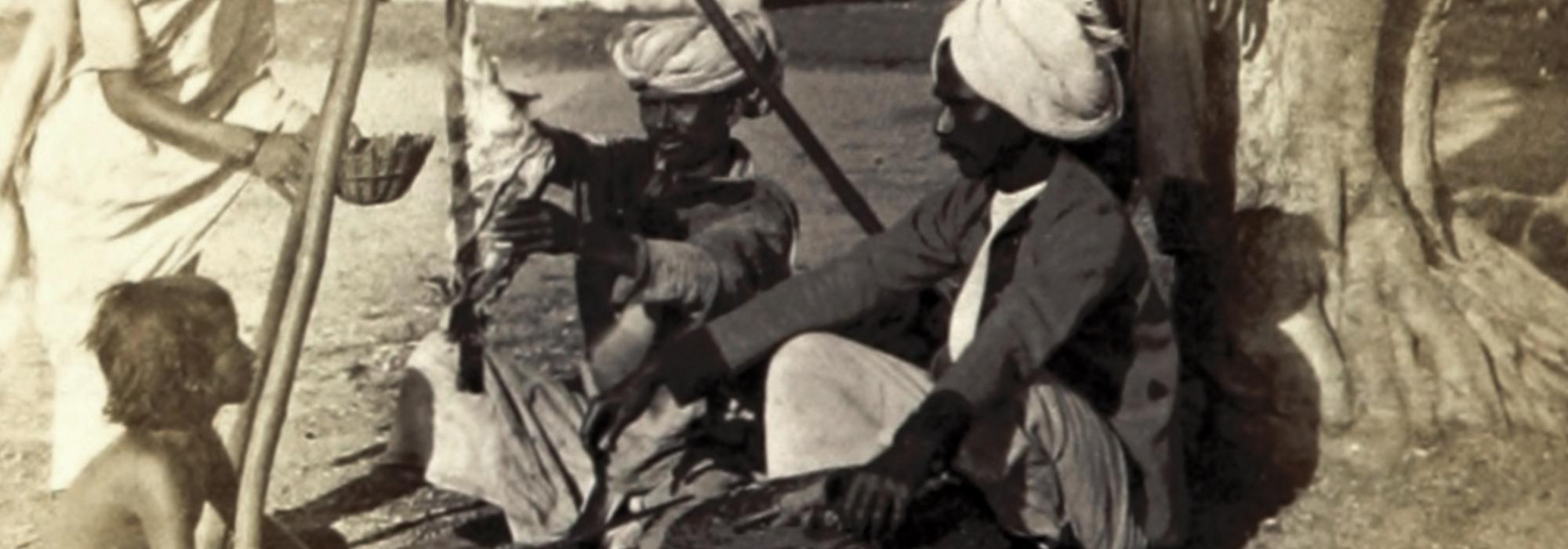In the Vana Parva (Book 3) of the Mahabharata, during the course of Yudhistira’s discussion with sage Markandeya, the latter narrates the story of Kaushika and Dharmavyadha. It is a wonderful episode of how a learned ascetic obtains life-lessons from an unlettered butcher in Mithila.
Following a series of incidents, Kaushika lands up at the shop of Dharmavyadha, who is busy selling deer and buffalo meat. Seeing the ascetic, Dharmavyadha rises from his seat and walks up to him. “Welcome, O holy one! Come, let us go to my house.”
Having reached the house, Kaushika is given water to wash his face and feet. Then he sits down comfortably and tells Dharmavyadha, “Why do you follow such a terrible profession? It’s such a pity that you are involved in this cruel trade!”
“This is the trade that my family has carried out for generations. I have just followed in their footsteps. I’m honest, contented, and free from envy. I donate to good causes as much as I can. I first offer to the gods, guests, family, and only then eat what remains. I don’t gossip. I sell pork and buffalo meat but I don’t kill those animals. I am a vegetarian. I respect my wife. I fast during the day and eat only at night. I treat everyone well – whether they speak well of me or not.
“A sinner swells up like a leather bag filled with win. The thoughts of such arrogant wretches never lead to natural goodness. A wise person, even though lacking beauty, displays brilliance by never speaking ill of others or highly of himself. Sinners usually cover themselves with virtue like the mouth of a well covers itself with long grass. On the outside, they appear holy and they preach the wisdom of the scriptures but one can never find them to be of virtuous conduct.”
Kaushika then asks, “How will I know what is virtuous conduct, O wise one?”
“Worship, charity, hard work, wisdom of the Vedas, and truth – these five are ever-present in conduct that can be called virtuous. Such people have subdued lust, anger, greed, arrogance, obsession, and envy. They take pleasure in goodness because it is good. They follow the practices of the honest and the good. Respect towards elders, integrity, freedom from anger, and generosity – these four are inseparably connected with good conduct. Truth is the essence of the Vedas. Self-control is the essence of truth. Detachment from worldly pleasures is the essence of self-control. This is indeed good conduct.
“Temptations are like sharks in the river of life and water is like the five senses; cross to the other side of this river in the boat of patience and detachment, avoiding the shallow patches of mere bodily existence! Good people are always kind to everyone. They never injure others and speak with courtesy. They are charitable and selfless. They can bring solace to the afflicted. They are respected by everyone. They always consider everyone’s welfare.”
Kaushika hears every word in rapt attention. Dharmavyadha continues, “Yes, my deeds are cruel, O wise one, but destiny is all-powerful. How can I evade the result of past actions? This is an evil that has its source in my previous life. But let me assure you, I try my best to remove evil. It is the Lord who takes a life; the executioner merely is a tool. Aren’t we all tools in the hands of the divine? The meat I sell are consumed by many people, bringing them joy. It is said that herbs, vegetable, deer, birds, and wild animals constitute the food of all beings. Also, in the early days, the story goes that in the kitchen of Rantideva, every single day two thousand cows were killed and thousands of people were fed. Similarly, animals are killed during yajna – they are said to become free of sin and reach heaven. And if Agni, the sacred fire, was not fond of meat in ancient times, perhaps it might not have become the food of everyone. This is perhaps why the ancient seers said that whoever consumes meat after offering it first to the divine doesn’t commit a sin.
“I obtain my livelihood from this profession. It is said to be a sin if you don’t do your work. And it is considered noble if you do your work well. Karma from previous lives never lets go of any creature. But at least I am generous, honest, free from pride, and refrain from idle talk. Everyone praises agriculture but even there, isn’t animal life harmed? When the farmer digs the earth, countless creatures die. And do you think that the seeds of rice don’t have life? Just like we hunt animals, we also cut down trees. What of the countless organisms on trees, in fruits, and in water? The whole of creation is brimming with life. While we walk or sit or sleep, we kill so many creatures – even the enlightened men and women! Non-violence as a rule was surely prescribed by those who had no understanding of reality. There is not a person on earth who is non-violent. The difference is only in the degree of damage.”
Then Dharmavyadha says, “The ways of dharma are subtle, diverse, and infinite. Sometimes, we have to tell a lie. A falsehood can lead to greater good than a truth. Therefore, truth isn’t absolute – whatever leads to welfare of the world is truth.
“Our life is a constant, unavoidable play of karma. Sometimes, intelligent and diligent people fail. At other times, violent and cunning people lead happy lives. Some attain prosperity without working hard while others who toil day and night are unable to achieve what they truly deserve.”
The conversation continues with Dharmavyadha explaining to Kaushika several aspects of life and living. It is an illuminating discourse of an unlettered butcher to a learned ascetic that covers some of the most fundamental truths of life in succinct and direct words.













































